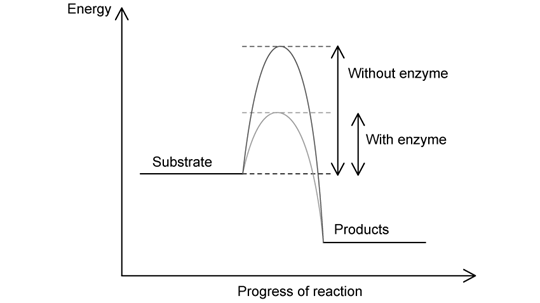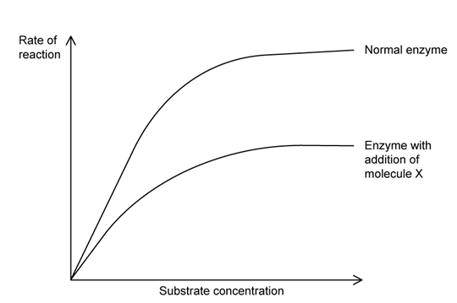a)
The graph below shows how enzymes affect biological reactions.
Use the graph and your own knowledge of enzyme function to explain how enzymes function as biological catalysts.
[ 1 mark ]
Assess your score
View Answer
b)
The graph shows how the addition of a molecule named here as molecule X affects the rate of an enzyme-controlled reaction.
Describe how the addition of molecule X affects the rate of reaction in the graph.
[2 marks]
Assess your score
View Answer
c)
The image below shows how molecule X interacts with the enzyme.
Use the image to explain the results shown in the graph in part (b).
[2 marks]
Assess your score
View Answer
d)
The image below shows another molecule, molecule Y .
Suggest how molecule Y might interact with the enzyme shown in part (c).
[1 mark]
Assess your score
View Answer
e)
Sketch a line on the graph from part (b) to show how molecule Y might affect the rate of reaction.
[2 marks]
Assess your score
View Answer
Next Question
a)
Define the term 'bioinformatics'.
[1 mark]
Assess your score
View Answer
b)
The parasite Plasmodium causes the disease malaria when injected into the human bloodstream.
Using bioinformatics, scientists can analyse the proteome of the Plasmodium parasite to better understand its metabolic pathways including the enzymes which catalyse them.
Define what is meant by the term proteome.
[1 mark]
Assess your score
View Answer
c)
So far over 300,000 chemicals have been screened to identify 19 new chemicals that can be used to treat malaria.
Calculate the percentage chance of finding a chemical that can be used to treat malaria.
Give your answer in standard form.
[3 marks]
Assess your score
View Answer
Previous Question Next Question
a)
State, with a reason, the type of enzyme inhibition shown in the image below.
[2 marks]
Assess your score
View Answer
b)
Explain what is meant by allosteric inhibition.
[3 marks]
Assess your score
View Answer
c)
The graph below shows the relationship between substrate concentration and rate of reaction for a normal enzyme and a competitive inhibitor.
Explain the effect competitive inhibition has on the rate of reaction.
[3 marks]
Assess your score
View Answer
d)
State an example of a competitive and non-competitive inhibitor.
[2 marks]
Assess your score
View Answer
Previous Question Next Question
a)
Metabolic pathways exist in all living organisms.
Explain what is meant by a metabolic pathway.
[3 marks]
Assess your score
View Answer
b)
Describe the differences between anabolism, catabolism and metabolism.
[3 marks]
Assess your score
View Answer
c)
Metabolic paths require enzymes. Hexose kinase is the initial enzyme needed during glycolysis, it catalyses the phosphorylation of glucose by ATP. This reaction would occur without the presence of hexose kinase.
[2 marks]
Assess your score
View Answer
Previous Question Next Question
One mark is available for clarity of communication throughout this question.
a)
This question is about metabolic pathways.
i) Describe the meaning of the term metabolic pathway.
[3 marks]
ii) Outline how end-product inhibition can act to limit a metabolic pathway.
[4 marks]
Assess your score
View Answer
b)
State some of the ways scientists can use bioinformatics to help with their research.
[4 marks]
Assess your score
View Answer
c)
Compare and contrast the allosteric and active sites of an enzyme.
[4 marks]
Assess your score
View Answer
Previous Question





